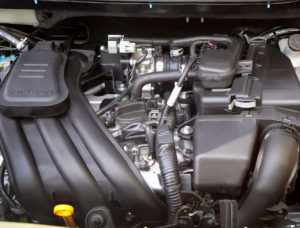
The HR10DE has an aluminum engine block with four main bearings and aluminum DOHC (dual overhead camshaft) cylinder head with four valves per cylinder (12 valves in total). The HR10DE is a Flex-Fuel engine and can use gasoline or ethanol.
It has a 78.0 mm (3.07 in) cylinder bore and 69.7 mm (2.74 in) piston stroke. Compression ratio rating is 11.2:1. The Nissan HR10DE produced 77 PS (56.6 kW; 75.9 HP) of horsepower and 98 Nm (10 kg·m; 72.3 ft·lb) of torque.
The breakdown of the engine code is as follows:
- HR – Engine Family
- 10 – 1.0 Liter Displacement
- D – DOHC (Dual Overhead Camshafts)
- E – Electronic Port Fuel Injection
General information
| Engine Specifications | |
| Engine code | HR10DE |
| Layout | Four stroke, Inline-3 (Straight-3) |
| Fuel type | Gasoline |
| Production | 2015- |
| Displacement | 1.0 L, 999 cm3 (60.96 cu in) |
| Fuel system | Multi-point fuel injection system |
| Power adder | None |
| Power output | 77 PS (56.6 KW; 75.9 HP) |
| Torque output | 98 Nm (10 kg·m; 72.3 ft·lb) |
| Firing order | 1-3-2 |
| Dimensions (L x H x W): | – |
| Weight | – |
Cylinder block
The HR10DE has an aluminum cylinder block with four bearing support system. Each piston is equipped with two compression and single oil control ring. The crankshaft and camshaft journals are finished with a polishing tape to produce a mirror-like finish.
| Cylinder block (after 2006) | ||
| Cylinder block alloy | Aluminium | |
| Compression ratio: | 11.2:1 | |
| Cylinder bore: | 78.0 mm (3.071 in) | |
| Piston stroke: | 69.7 mm (2.74 in) | |
| Number of piston rings (compression / oil): | 2 / 1 | |
| Number of main bearings: | 4 | |
| Cylinder inner diameter (standard): | 78.000-78.015 mm (3.0709-3.0715 in) | |
| Piston skirt diameter (standard): | 77.965-77.980 mm (3.0695-3.0701 in) | |
| Piston pin outer diameter: | 18.996-19.002 mm (0.7479-0.7481 in) | |
| Piston ring side clearance: | Top | 0.040-0.080 mm (0.0016-0.0031 in) |
| Second | 0.030-0.070 mm (0.0012-0.0028 in) | |
| Oil | 0.045-0.125 mm (0.0018-0.0049 in) | |
| Piston ring end gap: | Top | 0.20-0.30 mm (0.0079-0.0118 in) |
| Second | 0.35-0.50 mm (0.0138-0.0197 in) | |
| Oil | 0.20-0.60 mm (0.0079-0.0236 in) | |
Maintenance data
| Valve clearance (HOT) | |
| Intake valve | 0.304-0.416 mm (0.012-0.016 in) |
| Exhaust valve | 0.308-0.432 mm (0.012-0.017 in) |
| Compression pressure | |
| Standard | 15.4 kg/m2 (15.1 bar, 219 psi) / 200 rpm |
| Minimun | 12.9 kg/m2 (12.7 bar, 183 psi) / 200 rpm |
| Compression differential limit between cylinders | 0.06 kg/m2 (0.06 bar, 0.9 psi) / 200 rpm |
| Oil system | |
| Oil consumption , L/1000 km (qt. per miles) | up to 0.5 (1 qt. per 1200 miles) |
| Recommended engine oil | 5W-30 |
| Oil type API | SN |
| Engine oil capacity (Refill capacity) |
With filter change 3.0 l (3.2 qt.) Without filter change 2.8 l (3.0 qt.) |
| Oil change interval, km (miles) | 5,000-10,000 (3,000-6,000) |
| Oil Pressure, kPa (bar, kg/cm 2, psi) |
Idle speed: More than 60 (0.6, 0.61, 9) 2,000 rpm: More than 270 (2.7, 2.8, 39) |
Valve clearance adjustment data
Calculate the thickness of new adjusting valve lifter so valve clearance comes within specified values.
R = Thickness of removed valve lifter
N = Thickness of new valve lifter
M = Measured valve clearance
Intake:
N = R + [M – 0.30 mm (0.012 in)]
Exhaust:
N = R + [M – 0.33 mm (0.013 in)]
Valve lifters are available in 26 sizes range from 3.00 mm (0.1181 in) to 3.50 mm (0.1378 in), in steps of 0.02 mm (0.0008 in).
Example (intake valve):
R = 3.10 mm
M = 0.52 mm
N = 3.10 + (0.52 – 0.30) = 3.32 mm, so we need a valve lifter with identification mark 332.
| Cold | Hot | |
| Intake | 0.26-0.34 mm (0.010-0.013 in) | 0.304-0.416 mm (0.012-0.016 in) |
| Exhaust | 0.29-0.37 mm (0.011-0.015 in) | 0.308-0.432 mm (0.012-0.017 in) |
Vehicle applications
| Model | Years Produced |
| Nissan March (Brazil) | 2015 |
| Nissan Versa (Brazil) | 2015 |
Be the first to comment